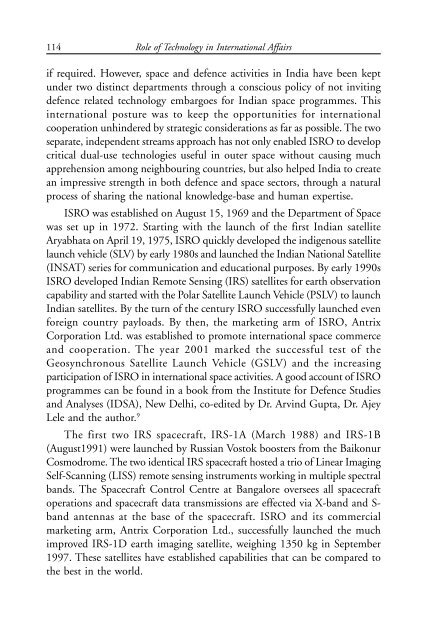ROLE OF TECHNOLOGY INTERNATIONAL AFFAIRS
book_role-of-technology-in-international-affairs_a-mallik_1
book_role-of-technology-in-international-affairs_a-mallik_1
Create successful ePaper yourself
Turn your PDF publications into a flip-book with our unique Google optimized e-Paper software.
114<br />
Role of Technology in International Affairs<br />
if required. However, space and defence activities in India have been kept<br />
under two distinct departments through a conscious policy of not inviting<br />
defence related technology embargoes for Indian space programmes. This<br />
international posture was to keep the opportunities for international<br />
cooperation unhindered by strategic considerations as far as possible. The two<br />
separate, independent streams approach has not only enabled ISRO to develop<br />
critical dual-use technologies useful in outer space without causing much<br />
apprehension among neighbouring countries, but also helped India to create<br />
an impressive strength in both defence and space sectors, through a natural<br />
process of sharing the national knowledge-base and human expertise.<br />
ISRO was established on August 15, 1969 and the Department of Space<br />
was set up in 1972. Starting with the launch of the first Indian satellite<br />
Aryabhata on April 19, 1975, ISRO quickly developed the indigenous satellite<br />
launch vehicle (SLV) by early 1980s and launched the Indian National Satellite<br />
(INSAT) series for communication and educational purposes. By early 1990s<br />
ISRO developed Indian Remote Sensing (IRS) satellites for earth observation<br />
capability and started with the Polar Satellite Launch Vehicle (PSLV) to launch<br />
Indian satellites. By the turn of the century ISRO successfully launched even<br />
foreign country payloads. By then, the marketing arm of ISRO, Antrix<br />
Corporation Ltd. was established to promote international space commerce<br />
and cooperation. The year 2001 marked the successful test of the<br />
Geosynchronous Satellite Launch Vehicle (GSLV) and the increasing<br />
participation of ISRO in international space activities. A good account of ISRO<br />
programmes can be found in a book from the Institute for Defence Studies<br />
and Analyses (IDSA), New Delhi, co-edited by Dr. Arvind Gupta, Dr. Ajey<br />
Lele and the author. 9<br />
The first two IRS spacecraft, IRS-1A (March 1988) and IRS-1B<br />
(August1991) were launched by Russian Vostok boosters from the Baikonur<br />
Cosmodrome. The two identical IRS spacecraft hosted a trio of Linear Imaging<br />
Self-Scanning (LISS) remote sensing instruments working in multiple spectral<br />
bands. The Spacecraft Control Centre at Bangalore oversees all spacecraft<br />
operations and spacecraft data transmissions are effected via X-band and S-<br />
band antennas at the base of the spacecraft. ISRO and its commercial<br />
marketing arm, Antrix Corporation Ltd., successfully launched the much<br />
improved IRS-1D earth imaging satellite, weighing 1350 kg in September<br />
1997. These satellites have established capabilities that can be compared to<br />
the best in the world.


